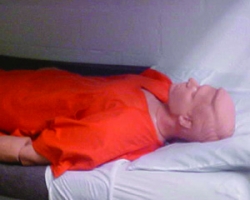
The description of the accommodations in the advertisement make the place seem inviting, more so than it really is: work release, flat screen TVs, a computer/media room, a clean facility and new beds. The location: the Seal Beach Detention Center.
“Seal Beach Detention CTR. Why spend your jail sentence of 365 days or less at county?” the advertisement asks.

The Seal Beach Police Department recently began marketing the city jail as a place to serve county time in LA Weekly.
The cost of running the ad: $1,000, according to an invoice obtained through a California Public Records Act request by Seal Beach resident and city budget watcher Robert Goldberg.
The advertisement is part of a long-standing effort to reduce the cost of having a city jail, which has consistently run a deficit for several years.
The 2013-2014 budget projects that the city jail will make $400,000 from renting jail space to inmates and another $10,000 in booking fees.The Police Department has an on-going marketing effort to attract pay-to-stay inmates to the city jail. The income from the inmates who pay to serve county jail time in the city jail offsets the jail’s biggest expense, its personnel, according to Lt. Bob Mullins, who commands the support services division of the department. Support services include the detention center.
Mullins said the department wanted to reach out to their client base. To offer the pay-to-stay service, the city has to get the word out. Mullins said the Police Department had tried advertising in bar association media outlets. He said an informal survey of Seal Beach inmates found that the Los Angeles publication was the most popular with the individuals who serve time in the city jail.
However, Mullins pointed out that it is still a jail. He said it is not comfortable. The walls and floors are cement. There is no sunlight. “It is dungeonish,” Mullins said. “We try to make it as liveable as possible.”
The pay-to-stay program has critics. Seal Beach resident Joyce Parque has called the jail a “bed and breakfast” for criminals at many City Council meetings since 2008. Then-Police Chief Jeff Kirkpatrick and his immediate successor, Interim Chief Robert Luman, both argued in favor of keeping the jail open. Both chiefs told the City Council that when officers processed prisoners at the Orange County Jail, it could takes three to five hours. In some circumstances, the process could take 12 hours.
Those officers were paid, but other officers had to cover their patrol duties. “The sole purpose of operating our ‘pay-to-stay’ jail operation is to keep our limited number of police officers out on the streets, in the neighborhoods, and patrolling our commercial zones and highways,” wrote then Chief Kirkpatrick in an April 2011 staff report to the council.
A private company once operated the city jail. The results were unsatisfactory: the jail operated at a loss. Under the private firm, some jailers were arrested for stealing from a pay-to-stay inmate and a former employee of the jail later conspired with a former inmate to commit a murder in another city.
The city let the contract with the private company expire, then closed and remodeled the jail.
City staff requested proposals from other private operators. Those operators who responded wanted Seal Beach to pay the expenses in exchange for which the private operators offered to split the profits with the city.
The jail reopened in February 2008. The stated goal for the jail at that time was to be “cost neutral,” which is a fancy way of saying city officials wanted to break even on the enterprise. In February 2012, Chief Luman told the council the jail would probably never achieve the goal of being “cost neutral.”



